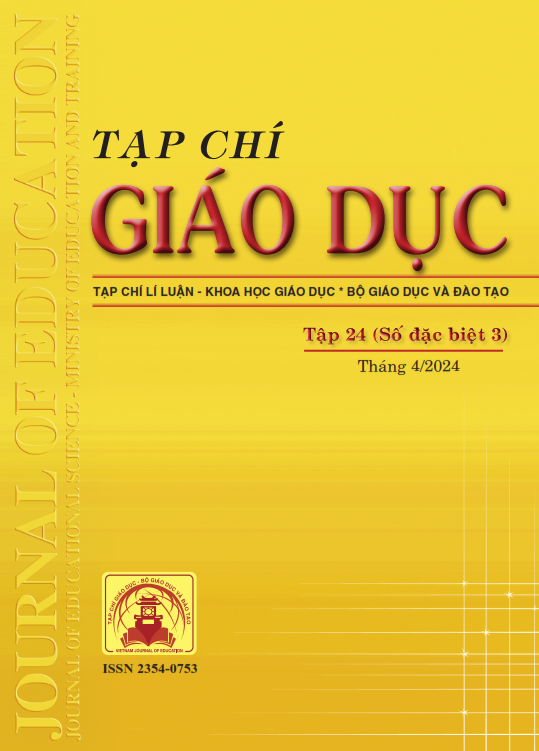Sự gắn kết giữa phương pháp dạy học với chuẩn đầu ra trình độ đại học: Cơ sở lí luận và thực trạng
Tóm tắt
Cohesion is an important foundation for evaluating the quality of training programs based on the compatibility between output standards, teaching methods and assessment methods. The paper investigates the alignment between teaching methods and learning outcomes in higher education, highlighting the theoretical basis and current situation at Can Tho University. It critically examines the coherence between intended learning outcomes, teaching methods, and assessment methods, emphasizing John Biggs's constructivist alignment principle. Despite the variety of teaching methods identified, the predominant use of traditional lecturing indicates a one-dimensional transmission approach, which may not effectively address the comprehensive learning outcomes required. The findings suggest a need for diversifying teaching methods to foster critical thinking, practical skills, and independent learning, aligning more closely with the intended learning outcomes and enhancing overall educational quality. Recommendations include faculty development programs to update teaching methodologies, ensuring a more integrated and effective curriculum design.
Tài liệu tham khảo
Al-Rawi, I. (2013). Teaching methodology and its effects on quality learning. Journal of Education and Practice, 4(6), 100-105.
Bakhru, K. M. (2018). Aligning teaching methods for learning outcomes: a need for educational change in management education using quality function deployment approach. International Journal of Learning and Change, 10(1), 54-69. https://doi.org/10.1504/IJLC.2018.10008662
Biggs, J. (2003). Aligning Teaching for Constructing Learning. Higher Education Academy, 1(4), 1-4.
Bligh, D. A. (2000). What's the use of lectures? First U.S. edition of the classic work on lecturing. California: Jossey-Bass.
Bộ GD-ĐT (2021). Thông tư số 17/2021/TT-BGDĐT ngày 22/6/2021 quy định về chuẩn chương trình đào tạo; xây dựng, thẩm định và ban hành chương trình đào tạo các trình độ của giáo dục đại học
Bourner, T., & Flowers, S. (1999). Teaching and learning methods in higher education: A glimpse of the future. Reflections on Higher Education, 9, 77-102.
Dale, E. (1969). Audio-visual methods in teaching (3rd ed.). New York: Holt, Rinehart and Winston.
Davis, J. R., & Arend, B. D. (2012). Facilitating seven ways of learning: A resource for more purposeful, effective, and enjoyable college teaching (1st ed.). Routledge.
Huỳnh Việt Nam, Nguyễn Ngọc Thắng (2021). Giới thiệu mô hình học tập phục vụ cộng đồng. Tạp chí Khoa học và Đào tạo thể thao, 17, 87-91.
Krejcie, R. V., & Morgan, D. W. (1970). Determining sample size for research activities. Educational and Psychological Measurement, 30(3), 607-610.
Lê Đức Ngọc (2009). Giáo dục đại học: Phương pháp dạy và học. NXB Đại học Sư phạm.
Majid, S., Rehman, F. U., Sultana , N., Chauhdry , A., Hafeez, A. U., Afzal , T., & Naseer , N. (2014). General methods of teaching. Allama Iqbal Open University Press.
Meier, B., & Nguyễn Văn Cường (2016). Lí luận dạy học hiện đại - Cơ sở đổi mới mục tiêu, nội dung và phương pháp dạy học. NXB Đại học Sư phạm.
Nguyễn Hữu Duyệt (2017). Thiết kế đề cương chi tiết học phần để tổ chức dạy học nhất quán với chuẩn đầu ra chương trình. Tạp chí Khoa học, Trường Đại học Đồng Tháp, 29, 144-152.
Nguyễn Thị Minh Phượng, Phạm Thị Thuý, Lê Viết Chung (2020). Cẩm nang phương pháp sư phạm. NXB Tổng hợp Thành phố Hồ Chí Minh.
Parish, A. (2012). The Relationship between Narrative and Engagement: Treating Lessons like Stories. CSM Ideas: Narrative and Storytelling, 1(9).
Phan Trọng Ngọ (2005). Dạy học và phương pháp dạy học trong nhà trường. NXB Đại học Sư phạm.
Quốc hội (2012). Luật Giáo dục đại học. Luật số 08/2012/QH13, ban hành ngày 18/06/2012.
Quốc hội (2019). Luật Giáo dục. Luật số số 43/2019/QH14, ban hành ngày 14/06/2019.
Rajan, S. (2012). Methodology of teaching Science. Pearson Education India.
Raman, S. K. (2021). Aligning Teaching-Learning Methods to Learning Outcomes.
Thủ tướng Chính phủ (2016). Quyết định số 1982/QĐ-TTg ngày 18/10/2016 về phê duyệt Khung trình độ quốc gia Việt Nam.
Trần Thị Hương, Nguyễn Đức Danh (2017). Tổ chức hoạt động dạy học đại học. NXB Đại học Sư phạm Thành phố Hồ Chí Minh.
Zakrajsek, T. D., & Nilson, L. B. (2023). Teaching at its Best: A Research-Based Resource for College Instructors. Jossey-Bass.
Zepeda, J. (2014). Stories in the Classroom: Building Community Using Storytelling and Storyacting. Journal of Childhood Studies, 39(2), 21-26.
Đã Xuất bản
Cách trích dẫn
Số
Chuyên mục
Giấy phép

Tác phẩm này được cấp phép theo Ghi nhận tác giả của Creative Commons Giấy phép quốc tế 4.0 .












